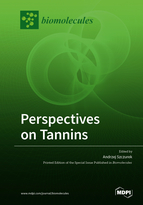Perspectives on Tannins
A special issue of Biomolecules (ISSN 2218-273X). This special issue belongs to the section "Natural and Bio-inspired Molecules".
Deadline for manuscript submissions: closed (20 March 2020) | Viewed by 42734
Special Issue Editor
Interests: bioresoursed organic and carbonaceous porous materials; adsorption; energy storage; catalysis; drug delivery; synthesis; design and modeling
Special Issues, Collections and Topics in MDPI journals
Special Issue Information
Dear Colleagues,
Tannins are a family of versatile, natural phenolic biomolecules whose main role is to protect plants against insects and fungi. Although this group encompasses a wide variety of oligomers and polymers, two main categories of tannins can be distinguished: hydrolysable tannins (HTs) and proanthocyyanidins, known also as condensed flavonoid tannins (PAs), which are resistant to hydrolytic degradation. Tannins contain aromatic rings bearing hydroxyl groups, which give them high chemical activity, causing them to form complexes with other macromolecules such as carbohydrates, polysaccharides, and bacterial cell membranes. However, their main characteristic is that they bind and precipitate proteins.
Due to their chemical reactivity, high availability in raw materials, and easy and safe extraction, tannins are widely used in the food, leather and chemical industries. Examples of current or potantial applications include their use in the production of anticorrosive primers; as “green” alternatives to synthetic homologous phenolic compounds for the production of wood adhesives, particle boards, and functional polymeric materials with variable physicochemical and morphological properties; and as anticancer agents against various tumor cell lines based on their antioxidant properties. In addition, the pyrolysis of these materials, i.e., heat treatment in inert atmosphere at elevated temperatures, results in cellular carbonaceous materials, further broadening the range of possible applications.
This Special Issue aims to bring together the perspectives on tannin research including new concepts for material synthesis, new applications of tannin-based materials or tannins themselves, and investigations of their fundamental (biological, chemical, electronic) properties using advanced characterization techniques.
Dr. Andrzej Szczurek
Guest Editor
Manuscript Submission Information
Manuscripts should be submitted online at www.mdpi.com by registering and logging in to this website. Once you are registered, click here to go to the submission form. Manuscripts can be submitted until the deadline. All submissions that pass pre-check are peer-reviewed. Accepted papers will be published continuously in the journal (as soon as accepted) and will be listed together on the special issue website. Research articles, review articles as well as short communications are invited. For planned papers, a title and short abstract (about 100 words) can be sent to the Editorial Office for announcement on this website.
Submitted manuscripts should not have been published previously, nor be under consideration for publication elsewhere (except conference proceedings papers). All manuscripts are thoroughly refereed through a single-blind peer-review process. A guide for authors and other relevant information for submission of manuscripts is available on the Instructions for Authors page. Biomolecules is an international peer-reviewed open access monthly journal published by MDPI.
Please visit the Instructions for Authors page before submitting a manuscript. The Article Processing Charge (APC) for publication in this open access journal is 2700 CHF (Swiss Francs). Submitted papers should be well formatted and use good English. Authors may use MDPI's English editing service prior to publication or during author revisions.
Keywords
- new tannin-based functional materials
- new synthesis methods
- new multidisciplinary applications
- fundamental properties







